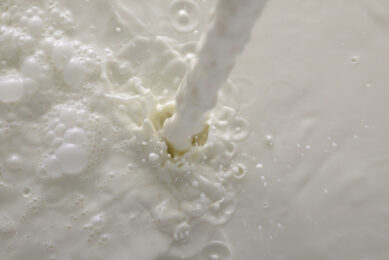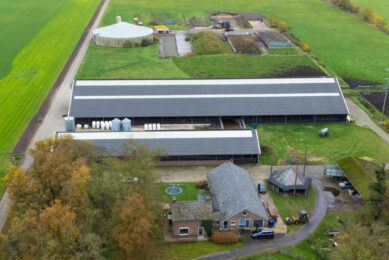New tool should help to select for better cows

Efficiency is key and the more the cow produces from the feed it consumed the better. But breeding for the ‘perfect’ cow entails more than selecting for this trait. A new selection tool will help farmers to select animals for feed efficiency without ?compromising on reproduction, health and ?longevity.
The human world population is expanding and the demand for food in the year 2050 is expected to be approximately 70% greater than the demand in 2010. Demands for livestock products are highly depended on income and therefore as population wealth increases, the demand for livestock products will also increase. Although feed efficiency is not synonymous with production efficiency, it will undoubtedly play a major role when production from a land base with limited potential to grow has to be increased. This increased production must, furthermore, be achieved without adding to the ecological footprint of production.
DNA markers and models
Genetic progress through selective breeding depends on accurate evaluation of breeding candidates. One of the key factors that impact the accuracy of this evaluation is relevant phenotypic information. Feed intake is a very costly phenotype and difficult to measure precisely on-farm, and accurate records of feed intake can thus be obtained only on a small scale within research facilities. One approach to increase accuracy of evaluation of residual feed intake (RFI) is to combine information on correlated traits which can be easily measured in large scale or already exist in current databases. The correlated traits must be either functionally related to RFI or useful as indirect measures of feed intake (e.g. milk components, activity, weight, methane in breath and information from metabolites).
Information from correlated traits and RFI measures from research facilities can be utilised in evaluating other animals in the population via the use of dense genome-wide molecular DNA-markers. Large gains in accuracy are expected when applying sophisticated statistical methods and models which are able to extract useful information from the correlated traits using genome-wide dense DNA-markers. In addition to accuracy, genetic progress through selective breeding also depends on the weights applied to the individual traits included in the breeding goal. It is therefore of utmost importance to estimate economic weights for the traits related to RFI if genetic improvement of RFI should be achieved. The concept of selecting for improved feed efficiency or residual feed intake (RFI) is highly attractive but may be difficult to implement in practice, primarily because individual feed intake records are unavailable in commercial dairy herds. RFI predictions will have low accuracy when individual feed intake measurements are not available but a number of developments can possibly improve the accuracy. Consequently, a stepwise approach must be taken when implementing the new tool, demonstrating step by step how RFI and thereby accuracy of RFI predictions can be further improved.
Number of new phenotypes
Genomic selection algorithms have the potential to generate (moderately) accurate EBVs for animals who have no phenotypic information because they share DNA with animals that do have registrations of the trait of interest. The accuracy of the genomic predictions is, however, a function of the number of animals with both genotypic and phenotypic information for the trait of interest and the genomic relationships between those animals and the animals with no registrations. Although genomic selection is now routinely used in the prediction of breeding values of dairy and beef cattle, actual phenotypes for the trait of interest (i.e., feed intake, milk spectras or methane emissions) are thus required and the incorporation of genomic information into genetic evaluations does not forgo the necessity to collect phenotypic information on traits of interest.
A number of new phenotypes, and potential indicator traits, emerges in the dairy industry and are used as management tools in the daily routines. Automated recording of physical activity was first developed with the purpose of detecting oestrus in cows and aid artificial insemination, but sensors are becoming more advanced and can now provide information about several behaviours including feeding time, rumination time and lying time, all being part of the total time-budget for the animal. Analysis of milk samples has recently advanced considerably by Fourier transformed infrared (FTIR) methods that allow for detailed description of fatty acid profiles as well as other milk components. Other methods including breath analysis for methane and metabolomics on blood plasma are still very new but also potentially strong indicators of metabolic efficiency likely to offer insights into intermediate efficiencies in the metabolic pathways leading to differences in overall efficiency. A selection line experiment in Australian beef cattle has shown that the difference in methane emission between a highly and a lowly efficient line resulted in 30% less methane emission from the efficient line.
Breeding goals
In order to select for improved feed efficiency, it must be included in the breeding goal. The breeding goal defines which traits are to be improved and how much weight to be given to each trait. In dairy cattle breeding, the weighting factors are usually economic values that are based on a model of a dairy herd production system. So far, no economic values have been derived for traits related to feed efficiency.
The author can be contacted at: jan.lassen@mbg.au.dk
A new Danish research project on feed efficiency
Aarhus University has started a new project (REFFICO) aimed at implementing an index for feed efficiency. The data will be generated in both research farms and on commercial farms. Hence, the researchers will estimate genetic and genomic correlations between the phenotypes registered – on indicator traits to improve accuracy and also on other breeding goal traits in order to avoid unfavourable correlated response. After this, the project team will develop new biometrical methods focusing on making genomic prediction on scarcely recorded phenotypes and the fifth work package will estimate the economic value of feed efficiency. The overall goal is to implement a selection tool for farmers that can be used to select for more efficient cows and at the same time at least stay on the same level for reproduction, health and longevity. The project is a four year collaboration between Viking Genetics, Aarhus University, NAV (Nordic dairy cattle breeding evaluation), SEGES, FOSS electronics, RYK (The Danish cattle registration) and GUDP (A funding unit under Ministry of Food, Agriculture and Fisheries of Denmark).










